Livestock farmers could boost their profits by 7% if they adopt ecological management practices, according to a new study.
The research, carried out by Scotland’s Rural College (SRUC), assessed the economic impact of four different ecological practices on Scottish livestock farms.
Researchers looked at data from 31 livestock farms across Scotland, collected from a large-scale survey of Scottish farms carried out between January and March last year.
They used an economic model – ScotFarm – to analyse the economic impacts of several ecological farm management practices.
These were: setting aside an ecological area on agricultural land; reducing farm inputs; switching from conventional to organic production; and setting aside agricultural land to plant trees.
The study found adopting two of the practices – creating ecological areas and reducing inputs – could deliver a 7% increase in farm profits, however the capital investment required to switch to organic production or plant trees were deemed challenging without the provision of financial support.
The initial cost of switching from conventional to organic production was estimated as £202 per acre in the study, while the cost of establishing and maintaining trees on farmland was estimated as £3,462 per acre.
The study said: “Changing the rationale for support, and engaging in promotion of wider agroecological policies should focus on the economic losses these practices may bring, but also changes in supply chains and consumers to recognise the benefits of these systems would also be needed to support a change.”
SRUC economist Shailesh Shrestha, who led the research, said adaptation of agro-ecological management practices by farmers was a potential approach to meeting the Scottish Government’s climate change plans.
“However, a critical issue is the economic impact of adoption of these practices,” added Dr Shrestha.
“Our research provided a snapshot of the economic impacts of a number of ecological management practices and economic challenges farmers face in adopting these practices on farms.”
